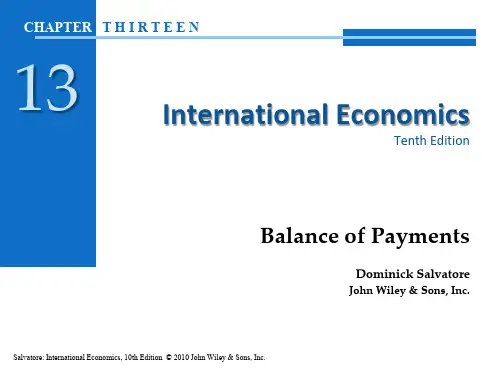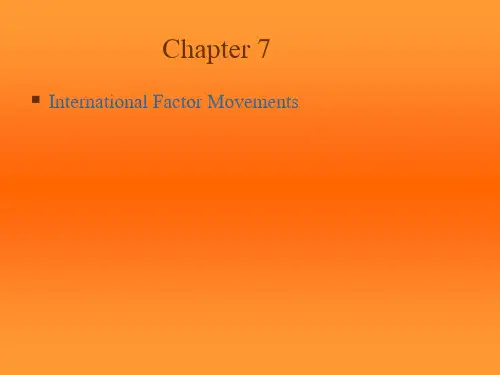国际经济学英文课件(萨尔瓦多第十版)ch07
- 格式:pptx
- 大小:1019.54 KB
- 文档页数:35
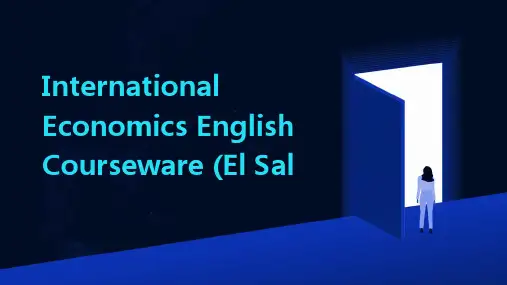
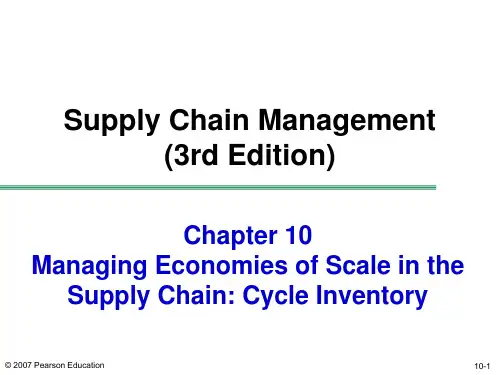


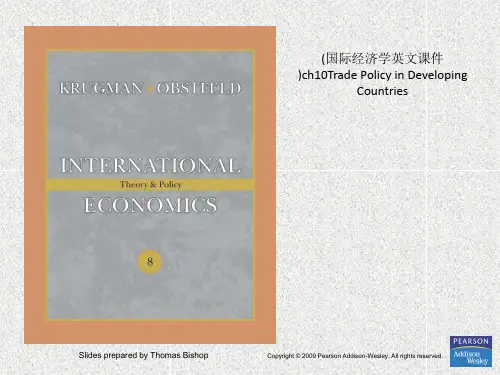
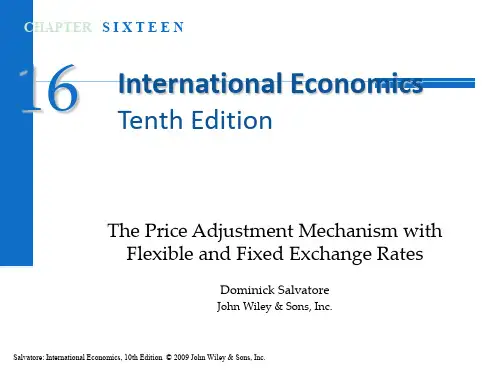
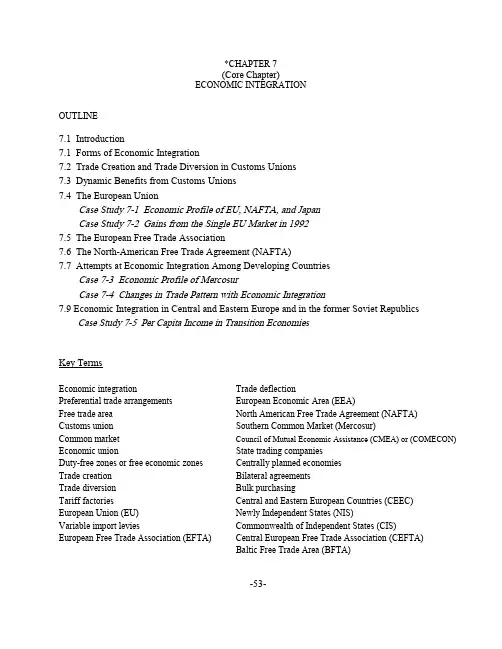
*CHAPTER 7(Core Chapter)INTEGRATIONECONOMICOUTLINE7.1 Introduction7.1 Forms of Economic Integration7.2 Trade Creation and Trade Diversion in Customs Unions7.3 Dynamic Benefits from Customs Unions7.4 The European UnionCase Study 7-1 Economic Profile of EU, NAFTA, and JapanCase Study 7-2 Gains from the Single EU Market in 19927.5 The European Free Trade Association7.6 The North-American Free Trade Agreement (NAFTA)7.7 Attempts at Economic Integration Among Developing CountriesCase 7-3 Economic Profile of MercosurCase 7-4 Changes in Trade Pattern with Economic Integration7.9 Economic Integration in Central and Eastern Europe and in the former Soviet RepublicsCase Study 7-5 Per Capita Income in Transition EconomiesKey TermsdeflectionTradeEconomicintegrationPreferential trade arrangements European Economic Area (EEA)Free trade area North American Free Trade Agreement (NAFTA)MarketCommon(Mercosur)SouthernCustomsunionmarket Council of Mutual Economic Assistance (CMEA) or (COMECON) Commoncompaniestradingunion StateEconomicDuty-free zones or free economic zones Centrally planned economiesagreementsBilateralTradecreationBulkpurchasingdiversionTradeandEastern European Countries (CEEC) factoriesCentralTariffNewly Independent States (NIS)(EU)EuropeanUnionVariable import levies Commonwealth of Independent States (CIS)European Free Trade Association (EFTA) Central European Free Trade Association (CEFTA)(BFTA)AreaBalticTradeFree-53-Lecture Guide:1. This is not a core chapter and I would skip it, except for sections 7-4 to 7-8 dealing with theEuropean Union (EU), The European Free Trade Association, the North American FreeTrade Agreement (NAFTA), and the Southern Common Market (Mercosur).2. I would take two classes to cover the material. Case Studies 7-1 to 7-4 can be used for a very stimulating class discussion.Answers to Problems:1. If Nation A imposes a 100 percent ad valorem tariff on imports of commodity X fromNation B and Nation C, Nation A will produce commodity X domestically because thedomestic price of commodity X is $10 as compared with the tariff-inclusive price of$16 if Nation A imported commodity X from Nation B and $12 if Nation A importedcommodity X from nation C.2. a. If Nation A forms a customs union with Nation B, Nation A will import commodityX from Nation B at the price of $8 instead of producing it itself at $10 or importing itfrom Nation C at the tariff-inclusive price of $12.b. The formation by Nation A of a customs union with Nation B leads to trade creationonly because Nation A replaces the domestic production of commodity X at Px=$10with tariff-free imports of commodity X from Nation B at Px=$8.3. If Nation A imposes a 50 percent ad valorem tariff on imports of commodity X fromNation B and Nation C, Nation A will import commodity X from nation C at the tariff-inclusive price of $9 instead of producing commodity X itself or importing it fromNation B at the tariff-inclusive price of $12.4. a. If Nation A forms a customs union with Nation B, Nation A will import commodityX from Nation B at the price of $8 instead of importing it from Nation C at the tariff- inclusive price of $9.b. The formation by Nation A of a customs union with Nation B leads not only to tradecreation but also to trade diversion because it replaces lower-cost imports of commodity X of $6 (from the point of view of Nation A as a whole) with higher priced imports of Commodity X from Nation B at $8.Specifically, Nation A's importers do not import commodity X from Nation C becausethe tariff-inclusive price of commodity X from Nation C is $9 as compared with theno-tariff price of $8 for imports of commodity X from Nation B. However, since thegovernment of Nation A collects the $3 tariff per unit on imports of commodity Xfrom Nation C, the net effective price for imports of commodity X from Nation C isreally $6 for Nation A as a whole.-54-5. a. See Figure 1 below.b. The net gain from the trade-diverting customs union shown in Figure 1 is given byC'JJ'+B'HH'-MJ'H'N. As contrasted with the case in Figure 7-1 in the text, however,the sum of the areas of the two triangles (measuring gains) is here greater than the area the rectangle (measuring the loss). Thus, the nation would now gain from the formation of a custom union. Had we drawn the figure on graph paper, we would have been able to measure the net gain in monetary terms also.6. A customs union that leads to both trade creation and trade diversion is more likely to lead to a net positive welfare gain of the nation joining the union (1) the smaller is the relative inefficiency of the union member in relation to the non-union member and (2) the higher is the level of the tariff imposed by the customs union on the non-union member.7. The dynamic benefits resulting from the formation of a customs union are (1) increasedcompetition, (2) economies of scale, (3) stimulus to investment, and (4) better utilizationof economic resources. These are likely to be much more significant than the static benefits.8. See Figure 2 below. The formation of the customs union has no effect.9. NAFTA created much more controversy because the very low wages in Mexico led togreat fears of large job losses in the U. S.10. The possible cost to the U.S. from EU92 arose from the increased efficiency andcompetitiveness of the E.U. The benefit arose because a more rapid growth in the EUspills into a greater demand for American products, which benefits the U. S.Fig 7.1xPFig 7.2xP-55-Multiple-choice Questions:1. Which of the following statements is correct?*a. in a customs union, member nations apply a uniform external tariffb. in a free-trade area, member nations harmonize their monetary and fiscal policiesc. within a customs union there is unrestricted factor movementd. a customs union is a higher form of economic integration than a common market2. A customs union that allows for the free movement of labor and capital among itsmember nations is called a:a. preferential trade arrangementb. free-trade area*c. common marketd. all of the above3. A customs union creates trade when:a. lower-cost imports from outside the customs union are replaced by higher-costimports from a union member*b. some domestic production in a member nation is replaced by lower-cost imports from another member nationc. trade among members increases but trade with nonmembers decreasesd. trade among members decreases while trade with nonmembers increases4. Trade diversion arises in a customs union if it:a. increases trade among union members and with nonmember nationsb. reduces trade among union members and with nonmember nations*c. increases trade among members but reduces trade with non-membersd. reduces trade among union members but increases it with nonmembers5. Customs union usually results in:a. trade diversion onlyb. trade creation only*c. both trade creation and trade diversiond. we cannot say-56-6. The formation of a customs union that leads only to trade creation and all economic resources of member nations are fully employed before and after the formation of the customs union leads to an:*a. increase in the welfare of member and nonmember nationsb. increase in the welfare of member nations onlyc. increase in the welfare of nonmember nations onlyd. increase or decrease in the welfare of member and nonmember nations7. A customs union that leads to both trade creation and trade diversion:a. increases the welfare of member and nonmember nationsb. reduces the welfare of member and nonmember nationsc. increases the welfare of member nations but reduces that of nonmembers*d. reduces the welfare of nonmembers and may increase or reduce that of members8. A customs union is more likely to lead to trade creation:a. the lower are the pre-union trade barriers of the member countries*b. the lower are the customs union's barriers on trade with the rest of the worldc. the smaller is the number of countries forming the customs union and the smallertheir sized. the more complementary rather than competitive are the economies of the nationsforming the customs union9. Which is not a dynamic benefit from the formation of a customs union?a. increased competitionb. economies of scalec. stimulus to investment*d. trade creation10. The formation of the EU resulted in:a. trade creation in industrial and agricultural productsb. trade diversion in industrial and agricultural products*c. trade creation in industrial products and trade diversion in agricultural productsd. trade diversion in industrial products and trade creation in agricultural products11. The benefit that the United States receives from NAFTA:*a. increasing competition in product and resource marketsb. greater technical innovationc. improvements in its terms of traded. all of the above-57-12. The benefit that Mexico is likely to receive from NAFTA:a. greater export-led growthb. encouraging the return of flight capitalc. more rapid structural change*d. all of the above13. Which is a stumbling block to successful economic integration among groups ofdeveloping nations?a. benefits are not evenly distributed among nationsb. many developing nations are not willing to relinquish part of their newly-acquiredsovereignty to a supranational community body, as required for successful economicintegrationc. the complementary nature of their economies and competition for the same worldmarkets for their agricultural exports*d. all of the above14. The formation of a free trade area among the countries of Eastern Europe is advocatedin order to:a. restore trade trading*b. retain the traditional trade links that can be justified on market principlesc. reduce the need for structural changed. none of the above15. The Members of Mercosur are:a. Brazil, Mexico, Argentina, and venezuelab. Argentina, Brazil, the United States and Peru*c. Brazil, Argentina, Paraguay, and Uruguayd. Brazil, Chile, Peru and Canada-58-。
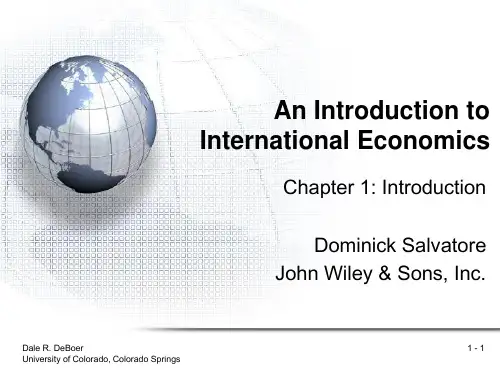
![[经济学]国际经济学 萨尔瓦多 英文PPTchapter](https://uimg.taocdn.com/d0fc87a6b9d528ea81c779dc.webp)
